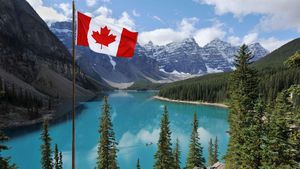Imagine a world where the survival of tiny, almost invisible sea creatures could dictate the health of whole ecosystems and, quite possibly, the balance of the planet. This might sound like the plot of a science fiction novel, but it’s the reality our oceans face today. These creatures, known as zooplankton, play an outsized role in maintaining the biological balance of our oceans and even in managing carbon levels in the atmosphere.
A recent study highlights how climate change is impacting zooplankton and, by extension, alters their vital contributions to the biological carbon pump. This term might bring to mind high-tech machinery, but the biological carbon pump is a natural process by which carbon is transported from the ocean's surface to its depths, effectively storing carbon and regulating our climate.
Zooplankton, the unsung heroes in this vast carbon management infrastructure, graze on phytoplankton at the ocean’s surface, transforming the carbon they ingest into either energy or waste that eventually sinks to the ocean's depths. It's a simple-sounding process but one fraught with complexities that researchers are only beginning to fully understand.
“Zooplankton respiration is a major loss term for organic carbon,” states the study. “Approximately 50% of the carbon ingested by zooplankton is respired, and this process is strongly influenced by temperature and body mass”. This means that as global temperatures rise, the way zooplankton consume and expel carbon could fundamentally shift. Since smaller zooplankton have higher weight-specific respiration rates, a warmer climate could see an increase in carbon being respired back into the atmosphere, disrupting this crucial carbon sink.
Numerous environmental stressors modulate zooplankton community structures. Among these, ocean acidification and warming favor some species over others, leading to significant shifts in their spatial distribution and seasonal timing. For instance, the study found that various zooplankton species are migrating towards the poles, a trend linked to their need to stay within specific temperature ranges suitable for their survival.
Historically, researchers have made some alarming discoveries about how climate change influences these tiny creatures. Longer time series have displayed some consistent, albeit concerning, trends like a decrease in zooplankton body size and earlier occurrences of seasonal species. Such changes in body size might lead to a shift in energy transfer efficiency throughout the ecosystem, affecting not just marine biodiversity but also the fishing industries reliant on larger zooplankton as a food source.
The implications of these changes extend beyond the oceans. Smaller zooplankton sizes and increased respiration rates could mean less carbon is transported to the ocean depths, making the biological carbon pump less efficient. It’s a domino effect: if zooplankton can’t effectively transfer carbon, the atmosphere retains more, exacerbating global warming. The efficiency of this carbon pump is, therefore, intricately connected to our global fight against climate change.
Understanding the broad consequences of these shifts begins with understanding their root causes. To comprehend the intricate functionality of zooplankton within this carbon management system, the research combines observational data with complex modeling techniques. These models simulate various environmental conditions to predict how future changes might affect zooplankton behavior and, consequently, global carbon cycles.
In particular, the study brings to light the role of “diel vertical migration” (DVM) – a process where zooplankton move up and down the water column within a 24-hour period. “The magnitude of the DVM-induced carbon flux depends on the species composition and biomass of zooplankton communities and can account for 4–70% of the total particulate organic carbon flux,” the study notes. This significant variability underscores the challenge researchers face in making accurate predictions.
Another key aspect is the selective grazing of zooplankton. By feeding on phytoplankton, they control the population of these microscopic algae, which, if left unchecked, could experience blooms that disrupt marine ecosystems and lower water quality. Yet, the relationship between grazing and warming climates is not straightforward. In some scenarios, increased temperatures may boost grazing pressure, reducing phytoplankton populations. In others, it could decrease zooplankton biomass, thereby reducing grazing and increasing phytoplankton standing stocks.
But the zooplankton story isn't just one of consumption; it's also one of redistribution. These creatures recycle essential nutrients like iron, nitrogen, and phosphorus, which are necessary for phytoplankton and other marine life. Remarkably, studies from the Southern Ocean reveal how certain types of zooplankton like Antarctic krill play a critical role in iron cycling, a nutrient often limiting in these waters. The krill’s fecal pellets release bioavailable iron, fueling phytoplankton growth and, thereby, supporting the broader Antarctic ecosystem.
However, this nutrient recycling is subject to change under warming conditions. As ocean temperatures rise, the efficiency of nutrient recycling by zooplankton might alter, undermining nutrient availability and impacting primary productivity. Given these creatures' pivotal role, even minor shifts can have cascading effects on oceanic food webs and carbon cycling processes.
Challenges in studying and modeling zooplankton come with their own sets of difficulties. Researchers rely on various technologies and methodologies from ship-based sampling to satellite observations. Yet, integrating these diverse data sources into cohesive models is fraught with complexity. Different zooplankton species have varied responses to environmental stimuli, making it challenging to create a one-size-fits-all model for predicting changes.
Moreover, the geographical and temporal scope of existing data is uneven. Most long-term zooplankton studies focus on the Northern Hemisphere, leaving significant gaps in our understanding of these dynamics in the Southern Hemisphere. Addressing these disparities is crucial for building a more holistic view of how climate change impacts global zooplankton populations.
Despite these challenges, the benefits of understanding zooplankton dynamics cannot be understated. Improved models can offer insights into policy-making and fishery management, ensuring sustainable practices that align with ecological realities. Moreover, understanding the nuanced roles of zooplankton in nutrient cycling can help refine climate predictions and conservation efforts.
Future research directions must include the continued development of integrated sampling techniques and long-term monitoring programs. Combining traditional methods with novel approaches, such as DNA metabarcoding and particle imaging, can enhance the accuracy and reliability of zooplankton data. These advancements will be instrumental in filling existing knowledge gaps and offering robust predictions for future environmental scenarios.
The study's final thoughts make it clear: “As we layer these uncertainties with those of zooplankton phenology, range shifts, and size, particularly noting the paucity of studies with, at times, contradictory findings from the Southern Hemisphere, we are unable to predict how zooplankton will modulate the biological carbon pump under future conditions”. The need for continued, exhaustive research is imperative, emphasizing a collective, global effort to monitor, model and understand these essential creatures.
Ultimately, this research paints a vivid picture of the complexities and vital importance of zooplankton in marine ecosystems and global climate regulation. Their future, interwoven with that of our planet, underscores the urgent need to address climate change impacts on all fronts, down to the smallest, most overlooked inhabitants of the deep.



